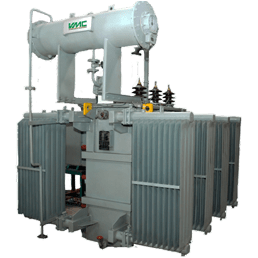Causes of Hot spot formation in Transformer
The winding is heated up by I2R losses, the core is heated up due to the core losses (hysteresis and eddy losses) inside the CRGO lamination stack. Losses will not be uniform in the core and the joints between limbs and yokes will have more losses (10-20 %) than the average unit weight loss (w/kg). Hence the temperature hot spot in the core will be near these core joints. In three-phase three limbed cores, this hot spot will be in the middle of the top yoke above the middle limb. In other types of cores, the hot spot will be slightly down in the upper part of the middle limb portion.
Moisture and oxygen cause the oil to decay much faster than the normal rate and form acid and sludge. Sludge settles on windings and inside the structure, causing transformer temperature to rise. If temperature increases, then conductor resistance increases and consequently transformer Output voltage and load voltage decreases. So, under voltage occurs if transformer temperature rises. Moisture lowers the dielectric strength of oil. Thus, insulating property decreases. So, breakdown voltage also decreases with increase of moisture content in oil, Moisture raises the temperature and hence dielectric power factor and increases the risk of thermal breakdown of solid insulation.
When the windings are loaded, leakage flux from the windings under the rated load will impinge on the outermost packets of the core, heating the surface due to the eddy current losses. This temperature rise can be a few kelvins to several tens of kelvins over the adjacent oil depending on the transformer winding, core, and tank shielding design. This creates hot spots.
In short, the real core hot spot temperature is a combination of the hot spot from the main flux, core surface heating from winding leakage flux, and temperature rise of the oil around the area of the surface hot spot.
Identification of Hotspot in transformer
There are few methods to identify and measure the hotspot temperature.
The conventional method of finding the hotspot temperature is indirect calculation method. Adding the temperature difference between the hot spot temperature in the transformer tank and the temperature of the top oil, the temperature rise of the top oil in the tank and the ambient temperature, the sum is equal to the hot spot temperature.
Other method is using fibre optical temperature sensors positioned at the predicted hotspot of the windings. The thermal sensors, attached to the end of optical fibre are usually placed between the insulated conductor and spacer, and their signals via optical fibre transmitted out of the tank.
When hotspots due to faults are created in the transformer winding, they lead to formation of hydrocarbon gases (H2, CH4, C2H4, C2H6, and C2H2), whereas faults involving the solid insulation of the transformer result in the formation of oxide gases (CO and CO2). Oil samples are taken from transformers and are analyzed for the existence of these gases. Then the approximate location of hot spots is found by using infrared images of the external surfaces of the power transformer.


Hi,
Your brand deserves to stand out, and we’re here to help.
At Global Wide PR, we specialize in connecting businesses with top media platforms to increase visibility and credibility. As a gesture to get started, we’re offering a free article on Digital Journal—a great way to showcase your business to a wider audience.
For those looking to maximize exposure, we can also feature your brand on affiliates of FOX, NBC, CBS, ABC, and 300+ other sites for just $297. These placements can help you build trust and attract new customers.
To take advantage of this opportunity, click the link below to sign up on our site, and we’ll get back to you ASAP:
https://bit.ly/globalwidepr
Looking forward to helping your brand shine!
Best regards,
Claudine
Global Wide PR
We respect that you might prefer not to receive our updates. To unsubscribe from our list, please complete this quick form with your website address: https://bit.ly/unsubscribemeurl
hello!,I really like your writing so much! share we communicate more about your post on AOL? I need a specialist on this space to unravel my problem. Maybe that’s you! Having a look ahead to see you.
Thought-provoking
Good clarity